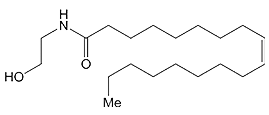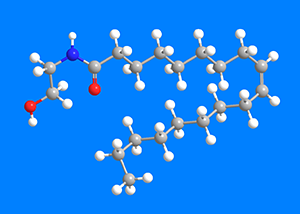What molecule am I?


Oleoylethanolamide (OEA) is a lipid that binds the α-type peroxisome proliferator-activated receptor (PPAR-α), which helps the body absorb, store, and use fat. It is produced in the small intestine and regulates feeding and body fat in vertebrates.
Recently, Wiebke K. Fenske and co-workers at Leipzig University discovered a connection between gastric bypass surgery and OEA. When the researchers performed the surgery on rats, they noticed that afterward the animals preferred low-fat to high-fat foods in their diets. Simultaneously, they observed that the intestinal biosynthesis of OEA increased.
Subsequent investigation revealed that the OEA pathway connects the intestines to the brain via the vagus nerve. When the scientists inhibited PPAR-α or severed the vagus nerve, the rats returned to their high-fat preference. Commenting on this study, other obesity researchers noted that if these results are confirmed in humans, OEA’s importance in the overall diet–obesity–surgery process must be established.

Learn more about this molecule from CAS, the most authoritative and comprehensive source for chemical information.
Molecule of the Week needs your suggestions!
If your favorite molecule is not in our archive, please send us a message. The molecule can be notable for its current or historical importance or for any quirky reason. Thank you!
Stay Ahead of the Chemistry Curve
Learn how ACS can help you stay ahead in the world of chemistry.

